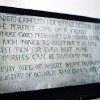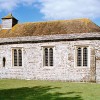The parish of West Parley was once larger than its present 1,000 acres, for until the mid 20th century it included parts of Hampreston and all of West Moors and was comprised mainly of heathland. It lies on the north bank of the River Stour and is on the boundary with Hampshire; its name is Saxon for Pear Tree Field.
Within its boundaries is Dudsbury, an Iron Age hill-fort, and several Round Barrows. On Parley Common are the remains of turf-cutting allotments formed in 1633 when the heath land was divided between the freeholders and the manor.
The Parish Church of All Saints stands in a pretty and tranquil spot at the end of a road beside the River Stour, probably the site of an earlier Saxon church. Parts of the present church, the nave, and the doorway, date from the 12th century; the chancel was probably built in the 14th century then enlarged in 1896. The walls are of Heath stone rubble, partly rendered with ashlar dressings; the roof is covered with tiles and stone slates. Late in the 15th century or early in the 16th century the north porch was added and later in that century the west wall was rebuilt and the western part of the roof altered to facilitate the construction of a wooden bell turret that houses a bell dated 1792 made by T Pyke of Bridgewater. The Font is ahead of you as you enter the church – parts of it date from the 12th century but the bowl is probably late medieval. The pulpit dates from the early 17th century and features a huge hexagonal sounding board added in the 18th century. The silver cup and cover-paten with the inscription 1574 are the work of Lawrence Stratfield of Dorchester. They were returned to the church during the incumbency of the Revd. Tower, who was Rector here for many years, having been installed in 1537.
Apparently, the church is not aligned exactly east-west and points to where the sun would rise on All Saints Day before 1752, the time of the change from the Julian to the Gregorian Calendar. Entrance to the churchyard is through a wicket gate and as you progress to the church porch and door you pass an aging wooden post that bears a sundial. This post was once part of the gallows that stood on Gibbet Firs at East Parley. Just inside the gate on your left is a gravestone in memory of two sisters who drowned in the River Stour on the 24th of January 1908, their mother was the school mistress at East Parley.
When the chancel of the church was enlarged in 1896 a burial urn was found at a depth of three feet and at a distance of five feet beyond the old east wall. Eight skulls, one with coins in the eye sockets, surrounded the urn, which can now be found in a glazed and barred recess in the east wall of the church. The inscription over the urn reads: “Until 1896, when the chancel was restored, the urn, said to have held the heart of the Lady of Lydlinch, who endowed this church, lay under the stone on which it now stands.” Tradition has it that the foundress and patroness of the church was a Norman lady, who rebuilt a former Saxon church, and gave for an endowment its glebe and certain tithes. She is said to have loved this place but her husband compelled her to go and live at Lydlinch in the Vale of Blackmoor. She asked that on her death her heart should be buried in the churchyard at West Parley.
On the 5th of December 1803 at Christchurch Priory the body of William Harbin, a farmer of Parley Green, was buried. His wife believed her husband was going to change his Will and was determined to stop this happening. She persuaded their son and his friend, John Guppy, to murder William. Found guilty after a trial at Winchester, the pair were brought to Gibbet Firs for execution, their bodies left to hang for some time. It is said the distressed mother became insane, spending days and nights scaring away birds and even attempting to feed the corpses by throwing potatoes into their mouths. The land owner eventually cut down the gibbet and presented part of the post to the Rector of West Parley, who used it as a support for the sundial in the churchyard.
The Domesday Book records West Parley as follows: “ Ralph of Cranborne holds West Parley. Brictnoth held it before 1066. It paid tax for 2 hides. Land for 2 ploughs, which are there. 5 villagers, 4 smallholders and 2 slaves. Meadow, 25 acres; pasture 1 league long and 7 furlongs wide; woodland 4 furlongs long and 1 furlong wide.” Nowadays West Parley is a busier place as you might expect, given its proximity to Poole and Bournemouth.



